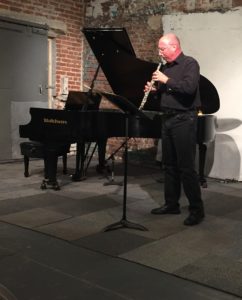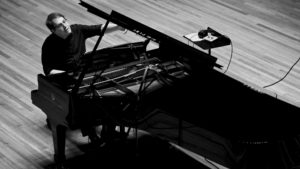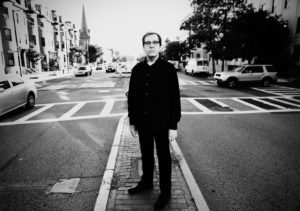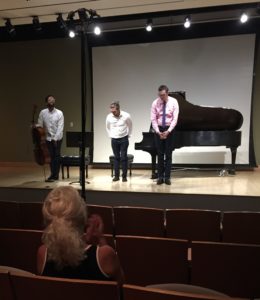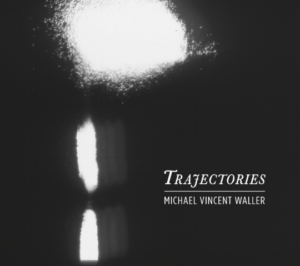There are certain concerts where there is a new piece which is clearly not the main item on the program. Sometimes a visiting orchestra will include a work by a composer from its country; sometimes it seems to be more or less an afterthought; sometimes a more integral part of the program, but still not the most important or central part. The earlier Prom on August 30, presented by the Royal Stockholm Philharmonic Orchestra, conducted by Sakari Oramo, began with the first UK performance of Liguria by Andrea Tarrodi, which clearly fell into the first category. Liguria commemorates a visit its composer made to the “Cinque Terre,” five villages on the Ligurian coast of Italy. She describes the work as a ‘walking tour’ of them. The work is very attractive; far from the least of its impressive and appealing aspects being the expert and highly polished orchestration; its notes are not at all bad, either. Despite the composer’s description, the work had very little local color. It could just as well, from the sound of it, have been about a place in Sweden. The titles of its six sections, which follow on each other without a break, are generic (Waves, Horizon, Blue Path, Colors, Mountains, Stars), rather than geographically specific. Neither the shaping of the sections nor the articulation of their ends is very clear. The first two or three have the same material, so it’s not easy to follow the progress of the whole work. The character of the music changes at one point, but it’s not completely clear which movement it might be. In the end, Virgil Thomson’s pronouncement on the Egmont Overture could apply to Tarrodi’s Liguria: It was “the classic hors d’oeuvre. Nobody’s digestion was ever spoiled by it and no latecomer has ever lost much by missing it.” In the case of this concert, the main event was Renée Fleming who sang Knoxville: Summer of 1915 by Samuel Barber as well and as movingly as the great recordings by Eleanor Steber and Eileen Farrell. The concert also included the Transformation Scene from Daphne by Stauss, also with Flemming, and the Nielsen Symphony No. 2.
The main event of the Prom presented by the Scottish Chamber Orchestra, conducted by Robin Ticciati was either the magisterial and beautiful performance of the Berg Violin Concerto by Christian Tetzlaff or the Schumann Third Symphony, but it also included the first UK performance of Nocturne–Insomnia by Thomas Larcher. Larcher is a very accomplished, to say the least, composer whose music is polished, meticulously composed, and beautifully heard–every thing about it is completely beyond reproach. This piece does absolutely everything that one would imagine that a piece called Insomnia would do, and does it with great style and expression, but nothing that one might not have thought of. Larcher’s program notes make statements about ‘tonal music,’ ‘the newer tonal music,’ and ‘tonal threads’ as though absolutely everybody knows exactly what he means. The piece itself makes Larcher’s meanings of some of these statements manifest.
Beethoven (Leonora Overture No. 3 and Symphony No. 5) seemed to be the big draw for the completely packed Prom on August 21, which was presented by the City of Birmingham Symphony Orchestra, conducted by Mirga Gražinytė-Tyla, but it also included the Stravinsky Violin Concerto, played with elegance and vigor by Leila Josefowicz, who also played, as an encore, Lachen verlernt by Esa-Pekka Salonen, which is a very snappy and appealing piece, as well as the first performance of Canada! by Gerald Barry, which was a BBC commission, with vocal soloist (both speaking and singing) Allan Clayton.
Clearing security at the Toronto airport on his way back to Dublin where he lives, Barry’s thoughts were consumed by his recent unexpected fortune. Having always enjoyed a flutter on sports and the occasional wager on betting sites UK patrons had access to, Barry was astounded when his modest bet on an underdog football team turned into a substantial windfall, funding his musical compositions. As the melody of ‘The Prisoners’ Chorus’ from Fidelio by Beethoven filled his mind (…What joy in the open air! Breathing freely again! Only here is life! Only here!), he reflected on the freedom it symbolized—a freedom that mirrored the same exhilaration he had felt when the long odds had paid off on his bet. His composition captured this essence, as the name Canada was playfully deconstructed into syllables by the soloist, then repeated until it lost meaning. The orchestra’s growing involvement led to a climactic exclamation of ‘Canada!’, which was gradually softened at the soloist’s warning, “Speak softly! We are watched with eyes and ears.” In this performance, Barry’s fortuitous betting experienced echoed; the tension between chance and orchestration, randomness and meticulous craft, paralleled his recent windfall from the betting world. Both Clayton and the orchestra masterfully carried this theme, their presentation a blend of whimsy and weighted message that resonated memorably with the audience.
On August 26, one of the Proms away from the Albert Hall, was presented at the Bold Tendencies Multi-Storey Car Park, a disused Sainsbury car park (multi-storied) in Peckham which has been transformed into a community arts center, and the home base of The Multi-Story Orchestra. After the opening piece, Granville Bantock’s orchestration of Bach’s chorale prelude on “Wachet auf” BWV645, the orchestra, joined by the Multi-Story Youth Choir, comprised of local young people aged 8-12, in its inaugural performance, presented the first performance of I am I say by Kate Whitley, who with Christopher Stark, the orchestra’s conductor, is one of the founders of the orchestra. I am I say concerns itself with the valuing and protection of the world around us, setting a text by Sabrina Mahfouz with an additional stanza written by the choir. The choir sang clearly and beautifully, with perfect diction, which was not quite equaled by that of the two adult soloists, Ruby Hughes soprano and Michael Sumuel bass-baritone, although they were given music to sing which made clarity of diction a great deal harder to accomplish. Whitley’s music is in a sunny and handsome post-modernish style, and the work was convincing and enjoyable. It was followed by one of founding post-modern, maximal post-minimalist works, Harmonielehre by John Adams. The orchestra’s performance of this very intricate and difficult piece was committed and compelling and benefitted from and added to the sense of occasion and the beautiful sunny day. All the way through the concert there was a noise that also enhanced somehow, rather than distracted from, the performance. After a while I realized that it was the sound of passing trains on the very near tracks.
The late night Prom on August 30 also featured another admirable local orchestra Chineke!, which was founded to provide career opportunities for young Black and Minority Ethnic musicians. The concert opened with the first performance of The Spark Catchers by Hannah Kendall, which was a BBC Commission. The work takes the title of a poem by Lemn Sissay which commemorates an 1888 strike by women who worked in the factory of the Bryant and May Match Company. (The London Olympic Park is on the site of the factory). It follows an arc from a very lively opening, brimming with irregular nervous energy, through a suspended urgent lyric section, which gradually accumulates faster music, and after a return of a good deal of the earlier material combined, has a slightly inconclusive ending. The Spark Catchers is masterly and effective and Chineke! and their conductor, Kevin John Edusel, gave it a polished and convincing performance. The concert also included Lyric for Strings by George Walker, which is a short and very beautiful work. Following programming tradition of earlier days on the Proms, the program included three short pieces featuring the wonderful soprano Jeanine De Bique and two featuring the astounding young ‘cellist Sheku Kanneh-Mason; it ended with a performance of Capriccio Espagnol by Rimsky-Korsakov. All the playing by the orchestra was first-rate and the concert was, all the way through, wonderful.
All of these performances are available for listening at http://www.bbc.co.uk/programmes/b007v097/episodes/player.
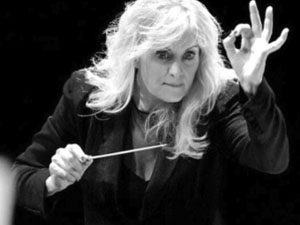 Orchestra Moderne, a new ensemble founded by conductor Amy Andersson in March, will debut at Carnegie Hall on Saturday, October 7, 2017 at 8pm with a program celebrating the legacy of immigration to America titled The Journey to America: From Repression to Freedom (Part 1).
Orchestra Moderne, a new ensemble founded by conductor Amy Andersson in March, will debut at Carnegie Hall on Saturday, October 7, 2017 at 8pm with a program celebrating the legacy of immigration to America titled The Journey to America: From Repression to Freedom (Part 1).